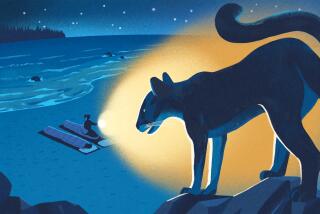CHANGING STRIPES : Once Steadfastly Opposed, Kathy Christian of West Hills Now Relishes the Thrill of the Hunt
- Share via
Kathy Christian performs all the usual household duties each weekend at her family’s two-story West Hills home. She vacuums the carpets. She does the laundry. She washes the kitchen floor. She dusts the wildebeest.
And, if time allows, she brushes the mouflon sheep, runs a damp rag over the horns of the greater kudu and straightens out the zebra-skin (and head) rug that adorns her dining-room floor.
This is no collection of moth-eaten relics salvaged from a pawn shop. These are genuine big-game trophies taken while on safari, and that they occupy wall space at the Christian home is rather remarkable.
Up until about a year ago, Christian, 42, was a woman steadfastly opposed to hunting. But with one not-so-perfect but still fatal shot from a .280-caliber rifle on a scorching African day in August last year, she became a hunter.
The transformation was extraordinary--and one that Christian finds difficult to explain.
Most people who have not hunted by the time they reach the age of 40 don’t change course. It is a sport instilled in youth by a hunting father or grandfather, most commonly in rural areas.
“For all of my life I was an anti-hunter,” Christian said. “When my husband went hunting, I would actually pray that the animals got away.”
Unfortunately for several animals that once roamed the South African veld and, most recently, a black bear that inhabited the woods of Alberta, Canada, Christian no longer feels that way about hunters.
In the months since her first kill, she has gone--without her husband, Fred--on hunts in Spain, where she took a fallow deer, and Alberta, where she overcame the hardships of a backcountry tent camp for a successful shot at a bear.
For 24 years, Fred Christian endured the wrath of his anti-hunting wife. A trip to Colorado to hunt deer would bring weeks of silent and not-so-silent protest.
As a hunter since boyhood, Fred understood the anti-hunting sentiment, especially in a place such as Los Angeles, which long ago abandoned any pretense of being anything but an enormous slab of cement upon which several million people live.
So he suffered the anti-hunting abuse silently. Always, he said, he wished his wife would try to understand his love of the hunt, his love of the outdoors.
But, it seemed, that was not to be.
“My idea of roughing it was going someplace in a motor home that didn’t have a microwave oven,” Kathy Christian said.
Finally, she was persuaded to accompany her husband on an African safari. She would shoot big game, she said, but not with a rifle. Her shots would come from a camera.
The dust swirled and the midday heat was at full bore now on the Thabazimbi plains of South Africa. Kathy Christian crouched at the base of a gnarled and twisted tree and felt her heart pound as a herd of antelope swept across the flat, grassy land. The first few were females, prancing nervously as their noses probed the air for danger. Seconds later, two males emerged from the brush. And Christian’s heart raced as she brought her massive rifle down and rested the barrel against the tree.
With an eye pressed to the scope, she scanned the distant bush. The cross hairs found the first male impala, but he passed quickly. A second later, the other male--a much bigger specimen--filled the scope. And, with only a gentle urging from her guide, she pulled the trigger and sent a bullet slamming into the animal.
And then, it ran.
“I felt no remorse about shooting him,” Christian said. “But I did feel bad that I didn’t kill him instantly. When he ran and we couldn’t find him, I just felt terrible. I thought how he must be suffering.”
The guide and Christian searched the plains for a long time and found no trace of the animal. Finally, they found it, no more than 40 yards from where it was shot, stiffening already as its lifeless body slumped against some dried shrubs.
“I said to myself, ‘Thank God it’s over,’ ” Christian said.
A few days later Christian took down a blesbok--an antelope indigenous to that area--and it wasn’t pretty. Her shot was not a killing shot and had only immobilized the 200-pound animal. She had to walk up to it and finish it off with a round into its chest from only 10 feet away. The impact made the blesbok’s body lurch backward.
And Christian looked into the animal’s eyes the entire time.
“He was looking at me,” she said. “I felt really terrible.”
The next day a male zebra fell to her gun. It was traveling, according to the guide, with two females that had, earlier in the week, been accompanying another male zebra, this one shot and killed by Fred Christian.
In all, the Christians took seven animals in those two weeks. Among their kill was a Cape eland that weighed about 1,500 pounds.
And all of those animals, along with others taken by Fred, are nailed solidly to the walls of their living room, eyes wide open as they seem to gaze out over the room. Often, their view is of the television set as it plays videotapes of the hunt that marked the animals’ final day.
It is a somewhat eerie feeling, sitting in the room watching a Cape eland who is, it seems, watching himself being shot.
Late last year Kathy went on the fallow deer hunt by herself in Spain. And in May, she and a woman companion who is a longtime member of Safari Club International, went to a remote site near Edmonton, Alberta. Christian dropped a 350-pound black bear that had been lured into her shooting zone by a mound of rotting food.
And if all of this makes a person want to stand up and shout, “Please. Stop shooting everything!” ... well, Kathy understands.
“When I shot my first animal, the impala, I felt no remorse at all,” she said. “And I was shocked that I didn’t feel that sadness that I thought I would. I felt guilty that I didn’t feel guilty.
“After I did it, all I could think was, ‘I have to have that animal. I have to have it mounted and bring it home. It’s mine.’ That’s why this room is filled with animals. Because both Fred and I want to have those heads as a lasting memory of what we did, of being out there with those animals, seeing the beauty of them.”
There has been a somewhat nasty reaction among members of the Christian family to Kathy’s new-found passion. Her mother, for example, strongly suggested that she find something else to do until the anxiety of mid-life crisis fades away.
A sister believes, Kathy said, that she is absolutely crazy.
And a daughter, Trish, 20, has to fight a feeling of nausea each time she passes through the living room. Which, by the way, she doesn’t do very often anymore.
“I don’t like hunting or anything associated with it,” said Trish. “I’m preparing to be a firefighter. I think it’s important to save life, not take it away. I am an animal lover.
“When all those heads came home, I moved out.”
Indeed, she did. One day this summer she strolled in, saw the heads of a mouflon sheep and a Corsican sheep that had been shot by dad, and headed out the door.
“She called us from a phone booth and said she wasn’t coming home until they were off the wall,” Kathy recalled. “The heads stayed up, and she didn’t come home that night.”
For all the people who don’t understand, for all the people who refuse to even try to understand, for all the anti-hunters, Christian has no bitterness.
She was, she remembers, one of them. “I see women wearing animal-skin shoes and they criticize hunting,” she said. “I see women in seal coats and beaver-skin coats, and they criticize hunting. I know I used to be like that. And now I know that those people just don’t see it. They just don’t get the whole picture of animals and hunting.
“A few years ago I ran over a little rabbit on a road in Moorpark. I got out and looked at the little thing and I cried about it for a long time.
“And if I ran over a rabbit today, I would cry just as hard.”
More to Read
Sign up for The Wild
We’ll help you find the best places to hike, bike and run, as well as the perfect silent spots for meditation and yoga.
You may occasionally receive promotional content from the Los Angeles Times.






